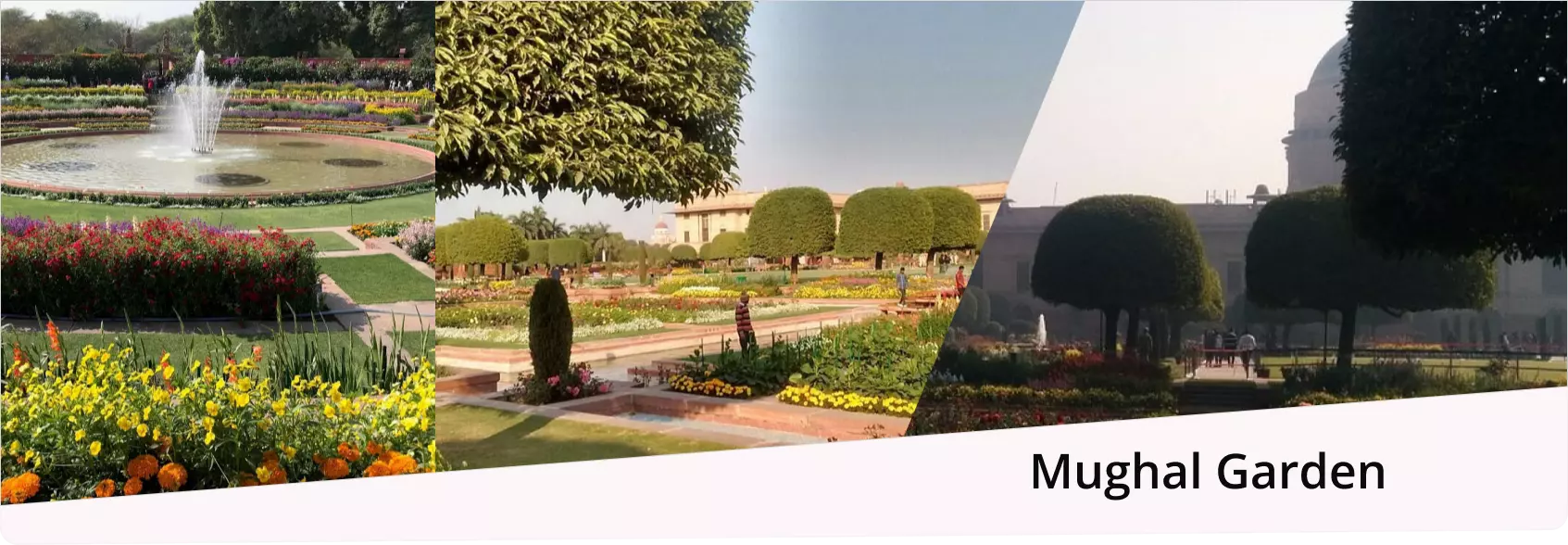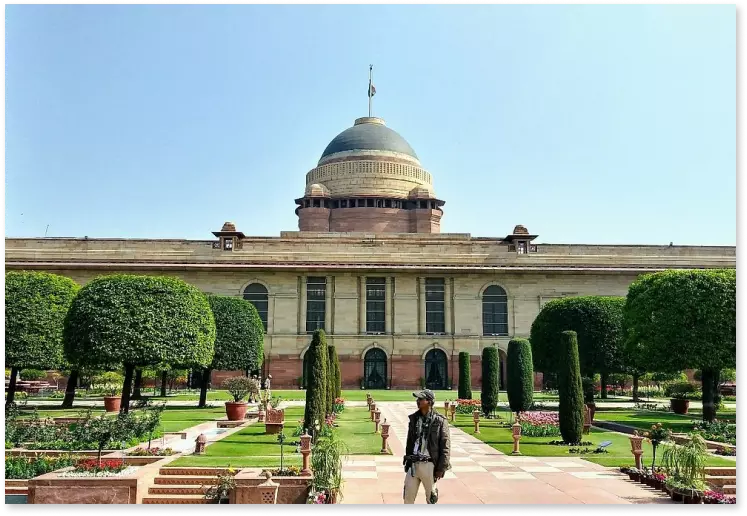
Attracting a horde of visitors every year in its natural glory of spectacular visual, sensual fragrance, and peaceful setting, the Mughal Gardens in the presidential palace Rashtrapati Bhawan in New Delhi is major sight of colorful attraction and is deservedly remarked as the soul of the Presidential Palace. A breathtaking union of British and Mughal style gardens, the place harbors an astounding assortment of various forms of flora and was devised by the British architect Sir Edwin Lutyens for Lady Harding. Sprawled across 15 acres of land, the Mughal Gardens take inspiration from the Mughal Gardens of Jammu and Kashmir , the gardens around the majestic Taj Mahal , and even the minuscule paintings of India and Persia. With a wide variety of flowers out of which more than 250 varieties are of Roses alone, the Mughal Gardens in Delhi is a breathtaking and a must-have experience.
The design of the garden was finalized by Sir Edwin Lutyens in 1917, but the actual plantation work began in the year 1928. In the biography called ‘The Life of Sir Edwin Lutyens’ by Christopher Hussey, Sir Lutyens’ wife has associated the garden as a ‘paradise’. She added, ‘’…the flowers are set in such masses, producing a riot of colors and scents, that, when with the fountains playing continually, there is not the least sense of stiffness. The round garden beyond beats everything for sheer beauty and is beyond words.’’
Roses are the prime feature and attraction of the Mughal Gardens even today. Some of the types of roses planted in the garden are exclusively named as ‘ Taj Mahal’, ‘Queen Elizabeth’, ‘John F Keneddy’, ‘Mr. Lincoln’, ‘Christian Dior’, ‘Raja Ram Mohan Roy’, ‘Arjun and Bhim’ from Mahabharata, and many more. People can visit Mughal Gardens once in a year during the ‘Udyanotsav’ festival in February and March, on all days except for Monday, when the garden is closed for maintenance. A prior appointment must be taken online to visit the Mughal Gardens the timings and dates for which are announced every year on the portal. The entire garden is segregated into square grids by two long channels running parallel vertically and horizontally.

Apart from the roses, the garden presents different varieties and colorful tulips, Asiatic lilies, daffodils, hyacinth, bougainvillea, daisy, pansy, trees, and shrubs including Moulsiri tree, Golden Rain tree, flower bearing Torch Tree, and many more. The expansive grounds of Rashtrapati Bhawan are not only used for colorful flowers but for other resourceful purposes. From wheat cultivation, to making Herbal Garden, Tactile Gardens for the visually handicapped, Musical Garden, Bio-Fuel Park, Spiritual and Nutrition Garden and much more have been cultivated at different times during terms of different presidents. The geometrical design of the garden is said to be appreciated more from the first floor of the building, first being the Rectangular Garden, followed by Long Garden, and finally the Circular Garden. The garden entry is through Gate No.35 of the Rashtrapati Bhawan, and a seating area is available inside the premises where the visitors can sit and relax while munching on some delicious snacks.
The Main Garden has been segregated into grids by two parallel strips running vertically from North to South and from East to West respectively. Six lotus-shaped water fountains are adorned in the junction of the grids and the mesmerizing cascade is set in such a manner and intonation speed that it seems to be frozen and exhibit a spectacular vision. The garden has more than 250 varieties of roses like Blue Moon, Lady X, rare Green Rose, Oklahoma, etc. and trees such as Bakul/Moulsri. Cypress and China oranges decorate the pavements and a horde of shrubs and scented flowers including Raat ki Rani, Juhi, Climbing Roses, Petrea, Harshingar, etc. delight the senses in a pleasurable manner. At the middle, there are stands kept with breadcrumbs for stray birds to feed from which add to the beauty of this nature’s wonder.
Circular Garden is situated very close to the Long Garden that is also a treat to the eyes with blooming flowers of different varieties. As per the name suggests, it comprises a circular flowerbed and carefully placed fountains where distinct varieties of butterflies and fragrant plants treat the sight and the olfactory nerves equally. The horticulture office, greenhouses, and nurseries are also present here to give the visitors a complete and heartwarming experience.
Terrace Garden is located at a slightly elevated ground on each side from the Main Garden as two longitudinal strips of green patch. At the center is a stunning water which flows inwards to make it look like a well and adorns the garden with its sparkling beauty. The tips on the western side are decorated with bowers whereas the eastern tips harbor two expanded designed sentinel posts.
Also called the ‘Purdah Garden’, the Long Garden is nestled towards the west of the Main Garden. Enclosed by 12 feet high walls, this is particularly a Rose Garden housing numerous stunning rose beds and captivating varieties of rose. The central pergola is covered and beautified with rose shrubs, grave vines, and bougainvillea. Creepers like Adenoclyma, Jasmine, Parana Paniculata, etc. on the walls, make this western end of the Main Garden lively.

The Mughal Garden in Delhi is opened for the public only for a short period of time from February to March during the festival of Udyanotsav. The time and the dates for visiting Mughal Gardens change annually and are announced shortly before the visiting commence. It is hence advised to check the dates and time online before visiting. The usual timings for public to visit are 10am to 4pm. There is no entry fee, only a prior appointment must be taken online before visiting the garden.
Delhi is well-connected by metros and state-run buses. The nearest metro station to Mughal Gardens is Central Secretariat Metro within 2km of distance. A cab can be booked, or a local rickshaw is also easily accessible from the station. One can also travel via the local DTC buses that run along the area regularly.

Referred to as the ‘soul’ of the Rashtrapati Bhawan, the exquisite and breathtaking Mughal Gardens is a meticulously spread sea of vibrant flowers and plants blending seamlessly the architectural perfection of Mughal canals and the European stye lawns and private hedges, that gives the garden its sheer beauty for which it is known for.
Copyright 2012-2022 Indiamap Digital Pvt Ltd. All rights reserved. Privacy Policy | Terms of Use